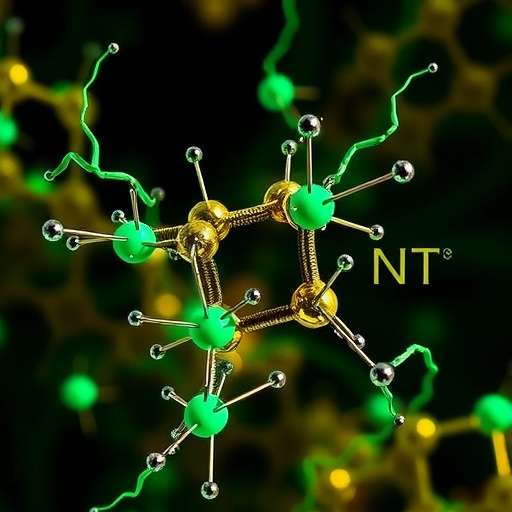In the ever-evolving landscape of cancer research, a groundbreaking study has illuminated a pivotal molecular player that orchestrates critical processes underlying tumor progression and drug resistance. The enzyme B3GNT5, a glycosphingolipid (GSL) synthase responsible for producing lacto- and neolactoside series precursors, emerges as a key regulator of the epithelial-to-mesenchymal transition (EMT), its reverse MET process, and chemoresistance in human cancers. This discovery, detailed in a recent publication in BMC Cancer, opens new vistas for understanding the metabolic underpinnings of malignancy and suggests promising therapeutic targets to combat aggressive tumors.
Glycosphingolipids are essential constituents of the plasma membrane with multifaceted roles in cellular communication, signaling, and structural integrity. Their dynamic regulation directly influences cancer cell behavior, including malignant transformation, metastasis, and response to chemotherapy. The biosynthesis of GSLs entails branching pathways governed by specific synthases, among which B3GNT5 holds a central position by catalyzing the generation of precursors critical for lactoside and neolactoside series GSLs. Prior to this work, detailed insights into how B3GNT5 affects tumor biology remained elusive.
Mining publicly available cancer genomic datasets, the researchers unveiled widespread copy number gains and overexpression of the B3GNT5 gene across a spectrum of human cancers. These genetic alterations consistently correlated with poorer clinical outcomes, underscoring the enzyme’s potential role in driving tumor aggressiveness. Such genomic amplification suggests a selective advantage conferred upon cancer cells through altered GSL metabolism mediated by B3GNT5.
.adsslot_pGEF1av5xW{ width:728px !important; height:90px !important; }
@media (max-width:1199px) { .adsslot_pGEF1av5xW{ width:468px !important; height:60px !important; } }
@media (max-width:767px) { .adsslot_pGEF1av5xW{ width:320px !important; height:50px !important; } }
ADVERTISEMENT
Strikingly, B3GNT5-depleted cells exhibited enhanced resistance to chemotherapeutic agents, a phenotype that has profound clinical implications. Chemoresistance remains a formidable barrier in cancer treatment, often driven by alterations in membrane composition and signal transduction pathways. The membrane’s GSL profile modulates receptor localization, clustering, and downstream signaling, and changes induced by B3GNT5 depletion appear to remodel these critical processes, enabling escape from drug-induced apoptosis.
Furthermore, the study sheds light on the enzyme’s influence on EMT and MET programs. The epithelial-mesenchymal transition enables epithelial cancer cells to acquire migratory and invasive capabilities, fueling metastasis. Partial loss of B3GNT5 altered the expression of EMT markers, hinting at a reprogramming of cellular states that can affect tumor dissemination and adaptability. Given the plasticity between EMT and MET states, B3GNT5 likely acts as a molecular rheostat balancing these transitions, thereby modulating both local invasion and metastatic colonization.
Signaling through receptor tyrosine kinases (RTKs) was also profoundly affected by B3GNT5 levels. Upon serum stimulation, key RTKs exhibited decreased activation in cells with reduced B3GNT5 expression. Since RTKs govern diverse oncogenic pathways, their attenuated phosphorylation suggests that disrupted GSL synthesis may impair membrane microdomain organization and receptor function, ultimately reshaping oncogenic signaling landscapes. This broad impact highlights the enzyme’s centrality in integrating metabolic and signal transduction networks within cancer cells.
This study exemplifies the power of integrating multi-omic data mining with precise genetic manipulation and advanced biochemical analyses to unravel complex cancer biology facets. By positioning B3GNT5 at the crossroads of metabolism, cell state transitions, and chemoresistance, it provides a unifying framework for how lipid modifications potentiate malignancy. These insights pave the way for innovative interventions targeting the glycosphingolipid landscape in oncology.
Future research will undoubtedly explore the intricacies of B3GNT5 regulation under physiological and pathological conditions, as well as the interplay with other enzymes within GSL biosynthesis. The cross-talk between lipid metabolism and genetic reprogramming in cancer cells represents an exciting frontier that could yield transformative therapeutic opportunities. Modulating cell membrane composition to influence signaling and drug response introduces a fresh paradigm in precision oncology.
Moreover, investigating B3GNT5 alterations across different cancer subtypes and treatment contexts will refine our understanding of its role as a universal mediator or context-dependent factor in tumor progression. Its interaction with the tumor microenvironment and immune modulation remains an open and promising area of inquiry, given GSLs’ known role in cell recognition and immune evasion.
The path from molecular characterization to clinical application is complex but underpinned by robust foundational discoveries such as this. Identifying and validating small molecule inhibitors or RNA-based therapeutics targeting B3GNT5 could revolutionize management strategies for refractory cancers exhibiting EMT phenotypes and chemoresistance. Personalized medicine approaches may incorporate B3GNT5 expression profiling to optimize therapeutic efficacy.
In summary, the emerging portrait of B3GNT5 as a master regulator of glycosphingolipid metabolism, EMT-MET plasticity, RTK signaling, and chemoresistance underscores its significance in cancer biology. The convergence of metabolic regulation and cell phenotype control through this enzyme offers a compelling target to disrupt malignant progression. As researchers continue to unravel its complexities, B3GNT5 stands out as a beacon of hope for more effective and durable cancer treatments.
Subject of Research: Regulation of epithelial-mesenchymal transition (EMT), mesenchymal-epithelial transition (MET), chemoresistance, and glycosphingolipid metabolism in cancer.
Article Title: Regulation of EMT-MET and chemoresistance by the Lc3Cer-synthase B3GNT5.
Article References:
Clark, L.E., Rorie, K.H., Dickinson, A.J.G. et al. Regulation of EMT-MET and chemoresistance by the Lc3Cer-synthase B3GNT5. BMC Cancer 25, 1356 (2025). https://doi.org/10.1186/s12885-025-14717-5
Image Credits: Scienmag.com
DOI: https://doi.org/10.1186/s12885-025-14717-5
Tags: B3GNT5 enzyme in cancercancer genomic datasets analysiscellular communication in cancerchemoresistance in tumorsepithelial-to-mesenchymal transition mechanismsglycosphingolipid biosynthesis pathwayslactoside and neolactoside series precursorsmetabolic underpinnings of malignancyoverexpression of B3GNT5 genestructural integrity of plasma membrane in malignancytherapeutic targets for aggressive tumorstumor progression regulatory factors





